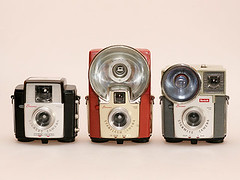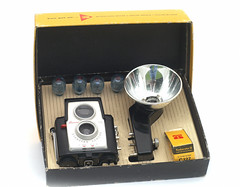Difference between revisions of "Kodak Brownie Star series"
m (Minor text edit) |
(→Links: Public domain commercials from my section in the Internet Archive. I hope it is OK to link to.) |
||
| Line 59: | Line 59: | ||
* [http://www.butkus.org/chinon/kodak/kodak_brownie_reflex_20/kodak_brownie_reflex_20.htm Reflex 20 manual] | * [http://www.butkus.org/chinon/kodak/kodak_brownie_reflex_20/kodak_brownie_reflex_20.htm Reflex 20 manual] | ||
* [http://www.butkus.org/chinon/kodak/kodak_brownie_twin_20/kodak_brownie_twin_20.htm Twin 20 manual] | * [http://www.butkus.org/chinon/kodak/kodak_brownie_twin_20/kodak_brownie_twin_20.htm Twin 20 manual] | ||
| + | ''Public domain television advertisements at Internet Archive'' | ||
| + | *[https://archive.org/details/1957CommercialForKodakBrownieStarflashAndStarflexCameras Starflash and Starflex] | ||
| + | *[https://archive.org/details/1960CommercialForKodakBrownieStarmiteCamera Starmite] | ||
| + | *[https://archive.org/details/KodakStarmatic1958 Starmatic] | ||
[[Category: Kodak|Brownie Star]] | [[Category: Kodak|Brownie Star]] | ||
[[Category: 127 film]] | [[Category: 127 film]] | ||
Revision as of 14:34, 22 December 2015
| ||
| ||
|
The Kodak Brownie Star series of cameras was a very successful range of simple plastic cameras. Over 10 million of these were made from 1957 to 1962, with the range continuing into the late 1960s. The original design was by Arthur H Crapsey. All were based on a similar layout: the film spools and a light baffle were mounted on a floor, which carried the advancing knob and a latch; the rest of the camera dropped down over this floor/spool assembly. Each model had various combinations of different viewfinder and flash arrangements - some built-in, some external, some with no flash facility. Some models were available in different colours, although black and grey seem to be the most common. The "star" name was applied to 127 film cameras, but there were similar models made for 620 film.
Models included:
- Kodak Brownie Starflash (127)
- Kodak Brownie Starflex (127)
- Kodak Brownie Starlet (127)
- Kodak Brownie Starluxe (127; a French Starmite)
- Kodak Brownie Starmatic
- Kodak Brownie Starmeter (127)
- Kodak Brownie Starmite (127)
- Kodak Startech (127; special close-up version of Starflash)
- Kodak Brownie Twin 20 (620)
- Kodak Brownie Flash 20 (620)
- Kodak Brownie Flashmite 20 (620; a larger version of the Startmite)
- Kodak Brownie Reflex 20 (620; a larger version of the Starflex)
These cameras were also manufactured under other names, and with slight variations for premium sales (such as the Bullet II - a Starlet without the flash contacts) and other languages, e.g. the Brazillian Rio 400.
Sources
- Coe, Brian, Kodak Cameras: The First Hundred Years, pp.53-57 Hove Foto Books, Hove, East Sussex, UK: 1988.
- Manuals on Mike Butkus's site
Links
Manuals at Mike Butkus's site:
Public domain television advertisements at Internet Archive


